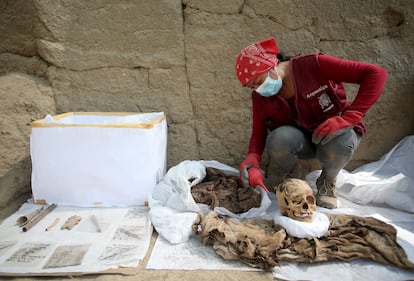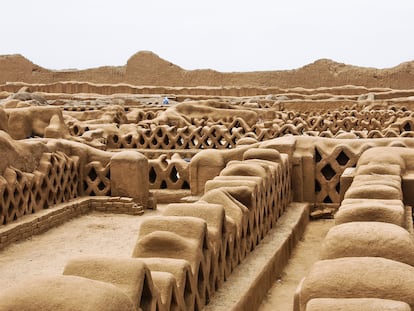How do we feel when we come face-to-face with our dead ancestors?
In ‘Empires of the Dead,’ historian Christopher Heaney uses Inca mummies to explore colonization, capitalism, anthropology’s origins and the impact of pre-Hispanic remains on the living

Three decades after the death of the revered Incan emperor Huayna Cápac, his great-nephew, the youthful mestizo Inca Garcilaso de la Vega, sought a personal encounter. Once the most formidable figure on the continent, Huayna Cápac’s body had been preserved in a manner that enabled him to remain in the realm of the living. Had the Spanish conquerors not arrived in Peru, he would have stayed in his regal mausoleum, communicating with the living through an intermediary. However, amid the chaos of the Spanish conquest’s pillaging, the ancient Inca’s remains found themselves in the hands of the Spanish regional governor in Cusco, Polo de Ondegardo. There, transformed into an enigmatic relic, Huayna Cápac’s body stood silent and inscrutable to European eyes.
He did not appear dead, as chroniclers noted. An earlier Incan emperor named Pachacuti also looked lifelike, with gold-covered eyes and an intact skull, except for a surgical incision. Where did such beings fit in this new world? Polo de Ondegardo disagreed with other conquistadors and believed studying Inca customs could aid the conquest. So he took five royal mummies to his house for analysis, creating an early anthropological laboratory.
The Incas were skilled not only in preserving bodies but also in cranial surgery. This ancient tradition of extending life beyond death, spanning thousands of years, is detailed by historian Christopher Heaney in his book Empires of the Dead (Oxford University Press, 2023). Ondegardo couldn’t quite grasp the reasons for this practice, but was aware that Garcilaso was heading to Spain and arranged a meeting between Garcilaso and his ancestor.

Years later, when he was a well-known writer in Spain, Garcilaso looked back with some regret on his encounter with Huayna Cápac. He realized he hadn’t been curious enough to learn more about his fascinating ancestor. Decades later, Huayna Cápac would vanish in a Lima hospital. However, on the day they met, Garcilaso plucked up the courage to touch the old Inca’s finger. It felt hard, like “a wooden statue.” His words conveyed a mix of sadness, frustration and apprehension about a world he couldn’t comprehend as it crumbled around him.
How do we feel when we come face-to-face with our dead ancestors? What happens inside of us? It’s all about who’s looking, who’s being seen, and the historical setting. We have the accounts of Garcilaso seeing Huayna Cápac (Royal Commentaries of the Incas, 1609) and Peruvian writer Gabriela Wiener viewing the remains of her ancestor Charles Wiener in a French museum (Huaco retrato, 2021). We also have Aymara writer Quispe Flores (Ciudad Apacheta, 2023) feeling more connected to bones in a glass case than to the country (Bolivia) that proudly displays them. In Empires of the Dead, Heaney explores 500 years of interactions between the living and the dead in the Americas, where bodies have been revered, looted, mourned and studied. Through Inca mummies, Heaney unravels colonization, capitalism and the birth of anthropology, revealing the impacts of pre-Hispanic ancestors on the living. “Andean ancestors and remains,” he notes, “have the power to stir and transform those who encounter them.”
Heaney’s book discusses how Spanish priests in the 17th century viewed mummies as pagan and burned them. The Indigenous people, who were forced to watch, mourned the loss of their ancestors. They felt the violence of the Spanish conquest, both in life and death. In 1687, surgeon Lionel Wafer tried to take a mummy home to London to study, but fearing curses, sailors threw it into the sea.
Politicians have even pressed mummies into government service. After General José de San Martín secured Peru’s independence from Spain in 1821, he sent a newly discovered mummy to the King of England as a diplomatic gesture. Expecting a place of honor in the Museum of London, the mummy instead ended up in a medical museum and vanished.
In the United States, scientists would have valued that wasted gift. Surgeons like George Morton, obsessed with proving the racial superiority of whites, collected skulls of “ancient Peruvians” to draw racist conclusions. Conversely, Quechua archaeologist Julio C. Tello saw proof in trepanned skulls (the practice of drilling a hole in a skull as a physical, mental or spiritual treatment) that ancient Peruvians excelled at brain surgery compared to modern Europeans. Heaney deemed Tello’s scientific contributions extremely significant for his anti-racist stance, offering a fresh perspective on the dead and their descendants.
According to Heaney, many colleagues in Peru and the United States disliked Tello because they saw him as an “insolent Indian.” They believed his role in society was to be studied, not to study others. Tello realized that the authority of those white academics didn’t stem from their achievements but from a history of suppressing Indigenous work and ideas. As a teenager, he came across an image in a book of a skull with signs of trepanation. The skull looked familiar — it was the same one his father had discovered and kept at home in Huarochirí, a Peruvian province in the Andes. The image was in an article by two scientists, one from Lima and the other from the U.S., but it didn’t credit the true discoverer. The lack of recognition of his father’s find made Tello feel like he had been silenced. When he finally held a skull himself, Tello felt connected to his race, which led him to become an anthropologist.

Like many Peruvians, I studied Tello and his discoveries in high school, but we never explored the personal scenes Heaney describes in his book. Teachers didn’t highlight transcendent Indigenous figures like Julio C. Tello and poet César Vallejo, who proudly and defiantly identified as “Indian” or “cholo.” In the 1990s, the only time the words “Indian” and “cholo” were spoken in school were in insults. Schools buried our Indigenous roots under layers of racism and shame. Tello had been silenced by the authorities in academia and education.
What to do? Heaney skillfully weaves historical narratives into present-day concerns, prompting readers to pause, reflect and even take action. An intriguing example involves Madeleine Fontenoit, who encountered a surprising truth while working at a Texas museum in 2014. When she opened a box labeled “Inca mummy,” Fontenoit encountered a girl of six to eight years. “She looked so out of place,” and Fontenoit became fixated on sending that body back home. Consider this — what is home for a person buried centuries ago, in another world, in another era? The girl was eventually transported to Peru’s National Museum of Archaeology, Anthropology and History, where she was hidden away in storage. Was that really where she belonged?
Every desecrated body was once a person who was denied their final rest. The Western world “discovered” America in 1492, but it took centuries to appreciate the inhabitants of this land. Empires of the Dead is thus titled because it explores the influence of various empires in the Americas, including the United States, where institutions like Harvard, Yale and the University of Pennsylvania selfishly used Peru to extract knowledge. Heaney describes a scene in 1965 in Washington, D.C. when the Smithsonian Museum unveiled its Hall of Physical Anthropology. A wall adorned with 160 “ancient Peruvian” skulls symbolized the explosive population growth on Earth. The skulls were arranged in the shape of a giant mushroom, with each one representing 100 million people. However, the skulls themselves held no significance. The Smithsonian Museum could have used tennis balls or apples with the same effect. The museum director justified their choice to a reporter: “We used Peruvian skulls because we have so many of them.”
The story of how those skulls ended up at the Smithsonian is partly the tragic tale of Peru. Between 1839 and 1929, Peruvian laws allowed tomb raids, and the freedom to keep and export finds. Explorers like Alĕs Hrdlička and Hiram Bingham sent Peruvian mummies and skulls to the U.S., and Peru was described as an open grave where tombs were easily plundered. The country’s rich raw materials included dead people, and guano shipments were occasionally mixed in with exported mummies. Grave robbing flourished as an industry, likened by Heaney to a form of mining in a world that was rapidly polarizing into industrial hubs and resource-supplying regions.
That history has left visible scars. The neighborhood I grew up in — Mangomarca — is located in the east of Lima. Instead of a typical central square with trees and benches, its focal point is an esplanade where a huaca stands. It’s an ancient mud pyramid called the Huaca de Mangomarca. No one in my neighborhood knew that it was 2,000 years old. There was no museum, no signs with historical information or telling people not to climb on the huaca. We lived in blissful ignorance of our own history. I enjoyed exploring the huaca on my bike, skillfully avoiding all the potholes. Occasionally, I stumbled upon teenage couples kissing in the huaca’s spooky cavities. We lived and loved amid a grand, forgotten past. They not only removed our deceased forebears but also erased the very history of the land.
While engrossed in Heaney’s book, my mind kept wandering back to that ancient huaca. As I shut my eyes, overwhelmed by the knowledge, I imagined those craters filling up again. The earth and its departed souls reunited, embarking on a journey of healing together — the ancestors and us.
Sign up for our weekly newsletter to get more English-language news coverage from EL PAÍS USA Edition
Tu suscripción se está usando en otro dispositivo
¿Quieres añadir otro usuario a tu suscripción?
Si continúas leyendo en este dispositivo, no se podrá leer en el otro.
FlechaTu suscripción se está usando en otro dispositivo y solo puedes acceder a EL PAÍS desde un dispositivo a la vez.
Si quieres compartir tu cuenta, cambia tu suscripción a la modalidad Premium, así podrás añadir otro usuario. Cada uno accederá con su propia cuenta de email, lo que os permitirá personalizar vuestra experiencia en EL PAÍS.
¿Tienes una suscripción de empresa? Accede aquí para contratar más cuentas.
En el caso de no saber quién está usando tu cuenta, te recomendamos cambiar tu contraseña aquí.
Si decides continuar compartiendo tu cuenta, este mensaje se mostrará en tu dispositivo y en el de la otra persona que está usando tu cuenta de forma indefinida, afectando a tu experiencia de lectura. Puedes consultar aquí los términos y condiciones de la suscripción digital.
More information
Archived In
Últimas noticias
Maduro pleads not guilty before the federal court in New York: ‘I am still the president of Venezuela’
A new test can detect Alzheimer’s from a finger prick
UN team enters Sudanese city of El Fasher after paramilitary massacre: ‘It’s like a ghost town’
A recipe for resistance: Indigenous peoples politicize their struggles from the kitchen
Most viewed
- Gilles Lipovetsky: ‘If you want to live better and fall in love, take Prozac, don’t look to philosophy’
- Alain Aspect, Nobel laureate in physics: ‘Einstein was so smart that he would have had to recognize quantum entanglement’
- Alvin Hellerstein, a 92-year-old judge appointed by Bill Clinton, to preside over Maduro’s trial in New York
- Why oil has been at the center of Venezuela-US conflicts for decades
- Maduro’s downfall puts China’s relationship with Venezuela to the test









































